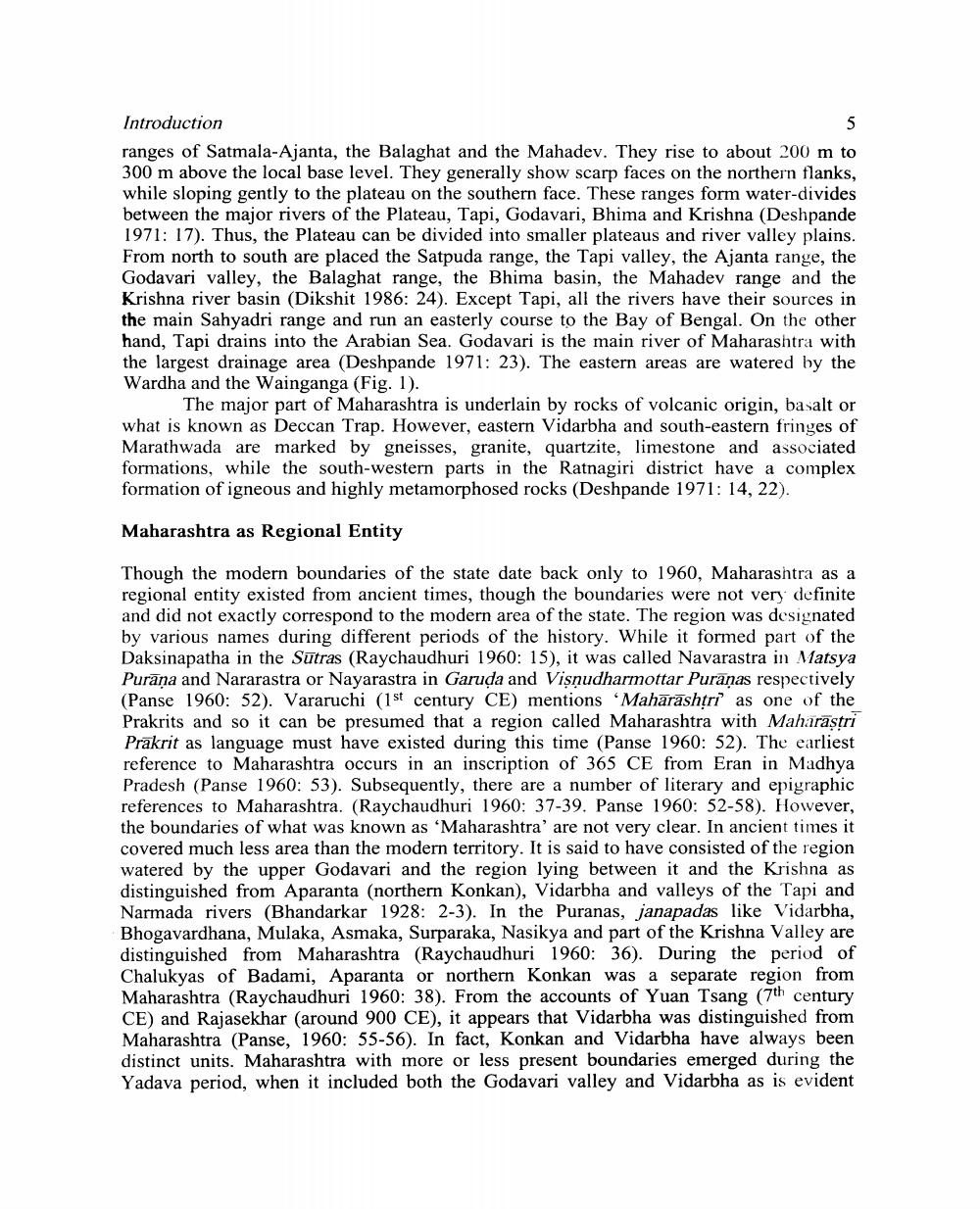________________
Introduction ranges of Satmala-Ajanta, the Balaghat and the Mahadev. They rise to about 200 m to 300 m above the local base level. They generally show scarp faces on the northern flanks, while sloping gently to the plateau on the southern face. These ranges form water-divides between the major rivers of the Plateau, Tapi, Godavari, Bhima and Krishna (Deshpande 1971: 17). Thus, the Plateau can be divided into smaller plateaus and river valley plains. From north to south are placed the Satpuda range, the Tapi valley, the Ajanta range, the Godavari valley, the Balaghat range, the Bhima basin, the Mahadev range and the Krishna river basin (Dikshit 1986: 24). Except Tapi, all the rivers have their sources in the main Sahyadri range and run an easterly course to the Bay of Bengal. On the other hand, Tapi drains into the Arabian Sea. Godavari is the main river of Maharashtra with the largest drainage area (Deshpande 1971: 23). The eastern areas are watered by the Wardha and the Wainganga (Fig. 1).
The major part of Maharashtra is underlain by rocks of volcanic origin, basalt or what is known as Deccan Trap. However, eastern Vidarbha and south-eastern fringes of Marathwada are marked by gneisses, granite, quartzite, limestone and associated formations, while the south-western parts in the Ratnagiri district have a complex formation of igneous and highly metamorphosed rocks (Deshpande 1971: 14, 22).
Maharashtra as Regional Entity
Though the modern boundaries of the state date back only to 1960, Maharashtra as a regional entity existed from ancient times, though the boundaries were not very definite and did not exactly correspond to the modern area of the state. The region was designated by various names during different periods of the history. While it formed part of the Daksinapatha in the Sūtras (Raychaudhuri 1960: 15), it was called Navarastra in Matsya Purana and Nararastra or Nayarastra in Garuda and Visnudharmottar Puraņas respectively (Panse 1960: 52). Vararuchi (1st century CE) mentions Maharashtri as one of the Prakrits and so it can be presumed that a region called Maharashtra with Maharastri Prakrit as language must have existed during this time (Panse 1960: 52). The earliest reference to Maharashtra occurs in an inscription of 365 CE from Eran in Madhya Pradesh (Panse 1960: 53). Subsequently, there are a number of literary and epigraphic references to Maharashtra. (Raychaudhuri 1960: 37-39. Panse 1960: 52-58). However, the boundaries of what was known as 'Maharashtra' are not very clear. In ancient times it covered much less area than the modern territory. It is said to have consisted of the region watered by the upper Godavari and the region lying between it and the Krishna as distinguished from Aparanta (northern Konkan), Vidarbha and valleys of the Tapi and Narmada rivers (Bhandarkar 1928: 2-3). In the Puranas, janapadas like Vidarbha, Bhogavardhana, Mulaka, Asmaka, Surparaka, Nasikya and part of the Krishna Valley are distinguished from Maharashtra (Raychaudhuri 1960: 36). During the period of Chalukyas of Badami, Aparanta or northern Konkan was a separate region from Maharashtra (Raychaudhuri 1960: 38). From the accounts of Yuan Tsang (7th century CE) and Rajasekhar (around 900 CE), it appears that Vidarbha was distinguished from Maharashtra (Panse, 1960: 55-56). In fact, Konkan and Vidarbha have always been distinct units. Maharashtra with more or less present boundaries emerged during the Yadava period, when it included both the Godavari valley and Vidarbha as is evident




